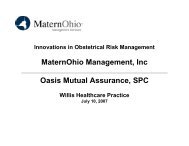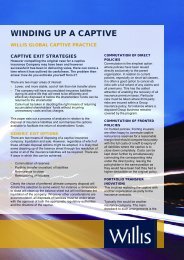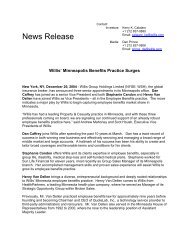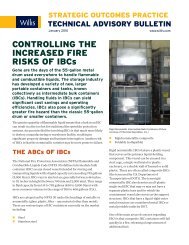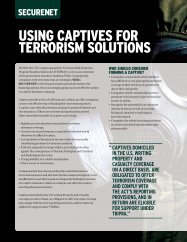construction project controlled insurance program (cip) - Willis
construction project controlled insurance program (cip) - Willis
construction project controlled insurance program (cip) - Willis
Create successful ePaper yourself
Turn your PDF publications into a flip-book with our unique Google optimized e-Paper software.
ISSUE OCIP CONSIDERATION CCIP CONSIDERATION<br />
controL of sitE safEty: Should an<br />
accident occur, it is likely the owner’s<br />
name, <strong>project</strong> and circumstances will be<br />
all over the news and in print. Studies have<br />
shown that an owner who takes an active<br />
role in ensuring that safety is managed can<br />
cut expected recordable accidents in half,<br />
with benefits that reach well beyond<br />
deductible losses in an <strong>insurance</strong> <strong>program</strong>.<br />
A team approach to safety should be<br />
employed whether an OCIP, CCIP or<br />
traditional <strong>insurance</strong> <strong>program</strong> is instituted.<br />
The Contractor is in the best position to<br />
manage safety on the <strong>project</strong> site. The<br />
owner should however take an active<br />
interest in <strong>construction</strong> safety. For<br />
instance:<br />
n Require site-specific safety <strong>program</strong><br />
from GC/ CM<br />
n Establish minimum safety requirements<br />
that also mirror what the insurer will<br />
require<br />
n Set safety as criteria in contractor<br />
selection<br />
n Maintain proactive involvement during<br />
<strong>construction</strong><br />
n Require contract language to include<br />
enforcement of safety <strong>program</strong> with<br />
consequences<br />
n Implement safety incentives<br />
n Include a line item for <strong>project</strong> safety<br />
in the <strong>construction</strong> budget<br />
Regardless of a CCIP approach, the<br />
owner should still take an active interest in<br />
<strong>construction</strong> safety. For instance:<br />
n Require site-specific safety <strong>program</strong><br />
from GC/CM<br />
n Set safety as criteria in contractor<br />
selection<br />
n Maintain proactive involvement during<br />
<strong>construction</strong><br />
n Require contract language to include<br />
enforcement of safety <strong>program</strong> with<br />
consequences<br />
n Implement safety incentives<br />
managing ciP cLaims: Regardless of<br />
who purchases the <strong>insurance</strong> <strong>program</strong>, the<br />
handling of claims can affect the finances<br />
and reputations of all parties involved,<br />
including the owner, contractors, and<br />
injured third parties and workers.<br />
cLaims ExcEEding PoLicy Limits: The<br />
only liability intrinsically created by a<br />
<strong>controlled</strong> <strong>insurance</strong> <strong>program</strong> is that of<br />
procuring <strong>insurance</strong> coverage as required<br />
by contract, and paying premiums and<br />
deductible losses.<br />
continuity of covEragE: Coverage that<br />
lapses can create severe problems for the<br />
owner and parti<strong>cip</strong>ating contractors.<br />
Owner manages claims to the benefit of<br />
injured parties and all <strong>project</strong> parti<strong>cip</strong>ants<br />
and is in the best position to manage<br />
public relations. Owner should include<br />
contractors in these discussions. They are<br />
concerned about their companies’<br />
reputations, the well-being of employees,<br />
and experience modification factor (EMR),<br />
which may affect pricing of their companyspecific<br />
<strong>insurance</strong> and are affected by<br />
workers compensation losses.<br />
Liability for claims exceeding policy limits<br />
remains with the negligent party. Owner<br />
should not specify that coverage for work<br />
on an OCIP be “excluded” on contractors’<br />
corporate <strong>program</strong>s, as this removes that<br />
source of recovery and may imply a<br />
limitation of liability.<br />
The owner is responsible for paying all<br />
premiums and deductible losses and<br />
thereby controls the continuity of the<br />
<strong>insurance</strong> <strong>program</strong>. Contractors should<br />
be provided ample notification in event of<br />
cancellation, nonrenewal or material change.<br />
Contractor manages claims, and may do<br />
so in a manner to minimize ultimate<br />
payout at the expense of other issues<br />
such as public relations. Contractor may<br />
not feel comfortable including other<br />
contractors in the discussion on open<br />
claims. Owner should be comfortable<br />
with the contractor’s approach to claim<br />
settlement prior to agreeing to a CCIP.<br />
Liability for claims exceeding policy limits<br />
remains with the negligent party.<br />
The contractor is responsible for paying<br />
premiums and deductible losses. Owner<br />
may require ample notification in the<br />
event of cancellation, nonrenewal, or<br />
material change.<br />
6



